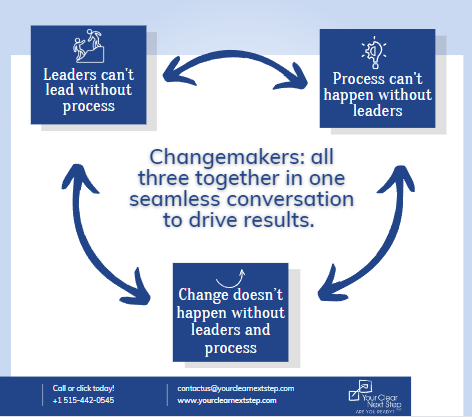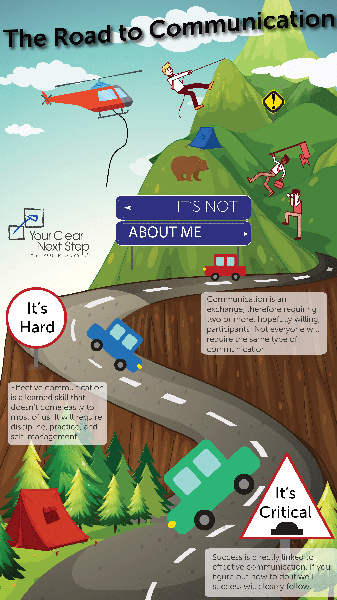3 Ways to Make Change Less Painful in Your Organization

Change in any business comes fast. And it seems that changes come faster today than they’ve ever come before, with no signs of slowing down. Just because things are moving fast or changing fast doesn’t mean that the people within and around the business have the skills, tools or information they need at their fingertips to handle the change well or to make the necessary changes “stick” the way they need to.

Common examples of significant changes might include upgrading to a new technical system or platform, launching a new product or service, hiring staff or expanding a team, moving locations or opening a new location or building, engaging a new fractional or full-time executive, implementing process or cultural changes within the organization … you get the idea.
While any one of these might be significant or expensive to execute, if an organization embarks on a change that doesn’t “stick,” the costs are exponentially higher.
Change can be one of the most disruptive forces in the workplace because of the impact it has on emotions and on operations. To manage that force well, leaders in organizations of all sizes need three key strategies: planning, communication and buy-in.
Planning
Some changes can happen without any advanced notice: think a tornado or a global pandemic on the setback side, or a market windfall or a serendipitous discovery on the jump-forward side. Even if the change itself was unexpected, the successful transition from where we are today to where we want to be requires planning. We need to plan for what “goal state” looks like and how we’re going get from here to there. If not, we flounder, often for much longer than we can afford.
And most changes in an organizational context (moving to a new system or platform, hiring a new team member, changing locations, etc.) happen on purpose. When we approach an endeavor like that, taking even a few moments to plan can increase our odds of successfully reaching our goals on time and on budget.
-
If the change at hand is quick and the number of people impacted is few, something small would suffice, such as:
-
an action list (who will do what by when)
-
a communication list (who will tell whom what, by when)
-
a risk list (what could derail us and who’s keeping an eye on it)
-
If the change at hand will take months, then project management is a great skill to leverage.
- For any size change, it’s critical to make sure that everyone understands what we’re doing and why we’re doing it!
- People are far more likely to leave the comfort of their current state if they can clearly see why goal state is obviously and urgently better than current state.
Planning doesn’t have to be exhaustive, and I’m not advocating that we give in to analysis paralysis. Instead, simply take a few minutes with the handful of other people who are responsible for getting the work done that will get us to our end point, and sketch out the high points, so we’re going in with a plan.

Communication
The leading cause of organizational pain tends to be summarized simply as “ineffective communication.” See if any of these pain points sound familiar:
-
Top-down messages aren’t getting through about what we’re trying to do and why it matters, so people on the front lines aren’t producing the results the leaders expect.
-
Bottom-up messages aren’t making their way to the top about the day-to-day challenges we’re facing or the reality of the constraints that are making the work difficult, so people on the front lines are frustrated that leaders aren’t helping them get the answers they need.
-
Side-to-side messages are skipped or muddled, meaning we’re not clear on which one of us is doing the work, leaving some work undone while other work gets done twice or micromanaged in a way that frustrates at least half of the participants. So, tensions build between people or teams creating unnecessary divisions where we should have unity, often damaging both end-customer trust and internal employee morale.
So what do we do about it? Take the time to be intentional in communications. When going through a period of change and transition, it’s important to recognize and incorporate each of the following:
-
Who are the different stakeholders who will need communication throughout this change journey?
-
What are the key messages they will need along the way? (HINT — there are about five different messages that most of us need during times of change, and delivering the right message at the right time makes a world of difference!)
-
Communication isn’t just a one-way thing! Remember that communication is a two-way street, which means that the communication plan needs to account for not just sharing information but also listening and adjusting the message, or answering questions based on what we hear.
-
Communication requires multiple modes and plenty of repetition! You’ve likely heard the adage that “in order for new information to stick, we have to encounter it seven times, seven ways.” That means we need written forms, like emails or handouts, as well as visuals, presentations, conversations, one-on-one discussions, small-group and large-group forums and also allow people to share what they’ve heard.
Communication can feel time-consuming, but communicating well up front can save us a lot of time in the long run! So much of what we teach at Your Clear Next Step involves effective communication, and we’ve made a slew of resources available for you.
Buy-in
The third key strategy, which can be supported by both good planning and effective communication, is buy-in. When those who are going through transition are really bought in, the change happens faster. We get to goal state sooner with less organizational pain.
Without buy-in, leaders give lip service to a cause they don’t really believe in, in hopes that their words will get people to follow. However, their true feelings show up in their actions, and after a few lackluster steps, we can all tell that no one is really following.
A better way to ensure followership is to allow leaders a chance to ask questions, dig in and really understand why this change is happening. Once the people who are leading the charge have had a chance to “secure their own oxygen mask,” they can better help the people around them.
Sometimes, because we’re afraid of what they might say or we’re not quite sure how to engage with them, the people who ask hard questions get shut out of conversations for being nay-sayers and “Debbie Downers.” The problem is that leaving these folks out ensures that they will not buy in at all.
A better way to secure buy-in from those who ask tough questions would be to greet their questions with something like, “Thanks so much for raising that concern, let’s figure that out together!” or “What would success look like from your perspective?”
Far too often, an assumption gets made that if we just throw some system or tool training in at the end, the rest will just fall into place. That’s unfortunately far from the truth. Training on the “what” and even the “how” is rarely effective if not everyone understands the “why.” And if individuals haven’t had the chance to address their own emotional responses to the impact this change has on their own lives, then they’re less likely to buy in and take the next step needed in the change journey.
A better way to secure buy-in for the group is to anticipate the way the different stakeholders will feel about the change — who is losing what, who is gaining what, how will they feel along the way — and give them tools and resources to effectively process their emotions.
I’ve been leading change initiatives with compassion since 2005. Helping people through change, and helping others lead change well is something I love to do, and our team has lots of resources available to you.
From independent contractor to self-employed to solopreneur to business owner, the entrepreneurial experience may be different, but some characteristics of the journey of change are remarkably similar, and the skills and competencies required to make change “stick” are consistent. A little bit of planning, some effective communication and careful attention paid towards securing buy-in from those involved can make a huge difference in the success level of the change.
If there’s anything I can do to help you, please reach out! My personal mission is to be useful, and the team and I at Your Clear Next Step are on a mission to help people have better workdays so that together we can co-create better communities.
If this topic interests you, hear more from me on the five ways to propel yourself into growth by registering for the Zoom session on Wednesday, May 22 from 9 – 10 a.m.
And don’t miss the Greater Des Moines Partnership’s other Top Five events in 2024, including:
-
Wednesday, Aug 28: Five Tips for Your Brand Communications | Learn More
-
Wednesday, Sept 25: Meaning Over Money | Learn More
-
Wednesday, Oct. 23: The Scaling Leader | Learn More
For more information on the Greater Des Moines Partnership’s Top Five series, visit the Business Resources page. While there, be sure to register for the next Top Five series. Learn more tricks on how to maximize the potential of your business through The Partnership’s through the Small Business Resources Hub.
The Greater Des Moines Partnership celebrates the Greater Des Moines (DSM) entrepreneur community and helps small businesses succeed with one-of-a-kind resources and opportunities for networking. Find out how other entrepreneurs have found success by reading their stories and attending local small business events in the region.
Sinikka Waugh
Sinikka Waugh, PMP, President of Your Clear Next Step, is a recognized leader in understanding people and adapting tools, techniques and processes to meet the demands of the situation at hand. Since 2008, Sinikka has helped over 50,000 people have better workdays so that together they can co-create better communities.